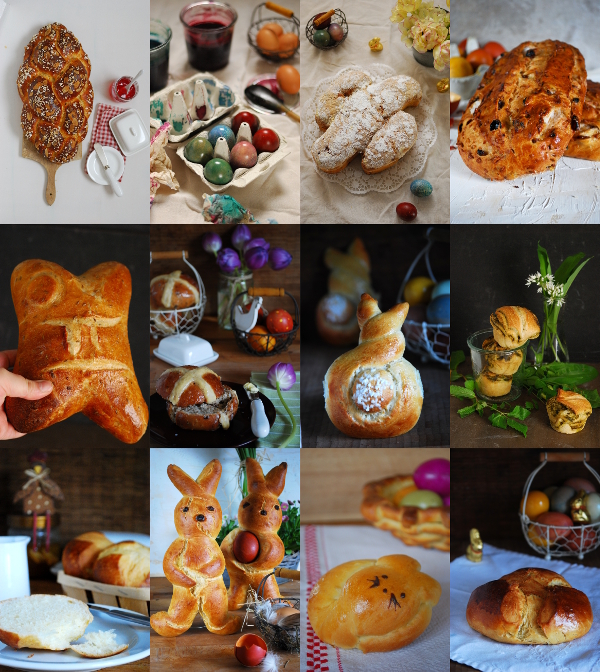Monthly Archives: March 2015
Bread baking for Beginners VI: Zuckerplatz (Sweet Bread)
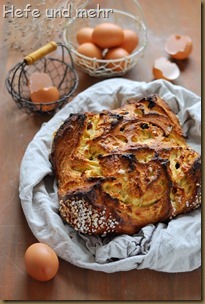 Last weekeend I realized how near Eastern is when my mom told me on the phone about her plans of dyeing eggs with her kids at school. And so I changed my plans for the bread baking course and developed a sweet recipe perfect for the Easter Breakfast. It is a sweet bread called which is made with the biga preferement. The subtle acidity of it helps to strengthen the gluten network. For a tender crumb the dough contains cream, egg yolk and some butter. By replacing the butter with cream the dough can rise in the fridge if needed.
Last weekeend I realized how near Eastern is when my mom told me on the phone about her plans of dyeing eggs with her kids at school. And so I changed my plans for the bread baking course and developed a sweet recipe perfect for the Easter Breakfast. It is a sweet bread called which is made with the biga preferement. The subtle acidity of it helps to strengthen the gluten network. For a tender crumb the dough contains cream, egg yolk and some butter. By replacing the butter with cream the dough can rise in the fridge if needed.
For all doughs with a lot of sugar or butter it is important to develop first the gluten network before butter and sugar. Both can inhibit the gluten development. The fat in the butter can coat the gluten proteins so that they can not connect with other gluten proteins to form strands while the sugar draw the water away from the proteins which again strongly reduce the forming of gluten strands. That’s why we will add the sugar in small increments after 10 min of intense kneading. You will realize while kneading in the sugar that the dough will become softer. This is due to the water which is no longer bound by gluten proteins because of the sugar. Continue reading
Bread baking for beginners V: Potato rolls with Biga
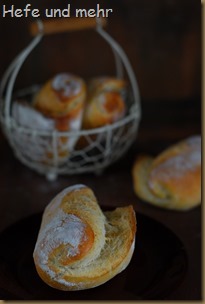 I mentioned already once or twice that I like to at potatoes into bread dough. In combination with a preferment they make the crumb soft and fluffy.
I mentioned already once or twice that I like to at potatoes into bread dough. In combination with a preferment they make the crumb soft and fluffy.
A classic preferment consist of flour, water, sometimes salt and microorganisms. In a sourdough the microorganisms are different lactobacteria and yeasts, while in a biga, poolish or pâte fermentée you will find bakers yeast (because you added them). A preferment will ferment for some time (mostly 12-16 hours) and in this time the microorganisms will release byproducts of their metabolism into the preferment. That makes the flavour of the dough (and later of the bread) complex and deep.
Goldknödel with Sweet Starter
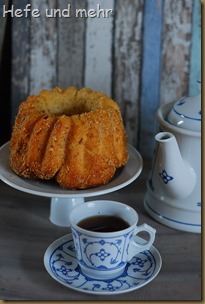 I love the fact that my sweet Starter enables me to bake more or less spontaneously with a delicious preferment. And when my parents asked us this morning if we want to meet in the afternoon for a cup of coffee I decided to bake a family classic: Goldknödel (Golden Dumplings).
I love the fact that my sweet Starter enables me to bake more or less spontaneously with a delicious preferment. And when my parents asked us this morning if we want to meet in the afternoon for a cup of coffee I decided to bake a family classic: Goldknödel (Golden Dumplings).
The recipe stems from the transsylvanian branch of the family and we all love it. My variant here contains less yeast, a preferment and cream instead of butter. This makes the crumb fluffy and enables me to proof the cake overnight if I want to. But today I choose the fast variant and proofed the cake at room temperature.
The cake is served uncut, and everyone can break a piece from it.
Breadbaking for Beginners IV: Buttermilk Loaf
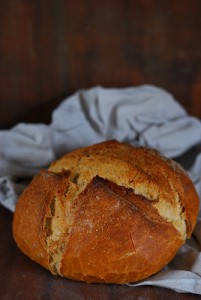 The next recipe for beginners is a bread made with buttermilk and some rye flour. These ingredients make the bread hearty and if you proof the dough over night in the fridge, the flavour will be even more complex. But if you need a fast bread, it is possible to let the dough rise for one hour instead.
The next recipe for beginners is a bread made with buttermilk and some rye flour. These ingredients make the bread hearty and if you proof the dough over night in the fridge, the flavour will be even more complex. But if you need a fast bread, it is possible to let the dough rise for one hour instead.
In contrast to the other breads we prepared in the little series, the dough will be a little bit sticky after kneading. This is due to pentosane in the rye flour and because of the higher water content. When kneading sticky dough I tend to leave the dough in the bowl and knead the dough by pulling the sides of the dough into the middle. One hand holds the bowl, the other do the folding. After 10 minutes the dough should come together nicely and can easily pulled away from the bottom of the bowl. Continue reading
New Recipe Index

While surfing through the blog world, I came across a niece WordPress-Plugin. Its named Visual Recipe Index and generates a recipe picture index sorted by categories. And humans are visual beings and pictures are often much more telling then recipe name, and so I directly installed the plugin additionally to my alphabetic Index. I fine tuned the CSS-Stylesheet until it fits my needs and added some anchors so you can jump now directly to the category you want to look at.
If you want to have a look:here is the new index…
Baking for Beginners III: Rolls
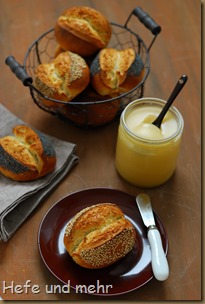 To me, the basic of good breakfast is a good roll. And so we are baking rolls in part three of our little bread baking course. These rolls are looking more complicated then they. For shaping we will use the same method then for the bread we baked last time. And already after 15 minutes the rolls are deeply cut, which is much easier than cutting a fully proofed roll. The cut is carefully laid together and will open beautiful during baking.
To me, the basic of good breakfast is a good roll. And so we are baking rolls in part three of our little bread baking course. These rolls are looking more complicated then they. For shaping we will use the same method then for the bread we baked last time. And already after 15 minutes the rolls are deeply cut, which is much easier than cutting a fully proofed roll. The cut is carefully laid together and will open beautiful during baking.
For a good volume the recipe uses on the on hand some fat and the lecithin from egg yolk and on the other hand a good kneading. For kneading such a firm dough I knead like that: I press the dough with the heel of hands away from my body. Then I draw the dough back to my body with my fingers. While kneading you need patient because it takes 10 minutes to reach middle gluten development. So turn on some music and knead ahead. At the end the dough should is soft but not sticky.
Orange powder
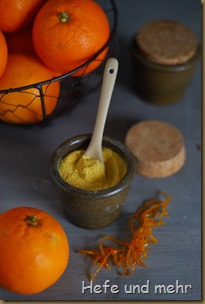 Since quiet some time I want to make Orange powder, which Bushcook published at chefkoch.de. Before I tested the powder I tend to dry orange zest during the winter and grinded them in the mortar when needed. But now I know the orange powder and I have to tell you: Forget about simple dried orange peel. The orange powder is way better. I know that it is more complicated but the flavour so much more intense due to the cooking before drying the zests.
Since quiet some time I want to make Orange powder, which Bushcook published at chefkoch.de. Before I tested the powder I tend to dry orange zest during the winter and grinded them in the mortar when needed. But now I know the orange powder and I have to tell you: Forget about simple dried orange peel. The orange powder is way better. I know that it is more complicated but the flavour so much more intense due to the cooking before drying the zests.
Because we buy mostly organic orange I had a lot of material for tweaking the recipe. Nowadays I do not peel them anymore but use a zester. And if I do not want to make the powder directly I place the zests in the freezer until I have time to proceed. I dry the zests after baking bread on the still warm bread baking stone. This reduces the amount of energy needed for the powder.

